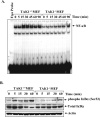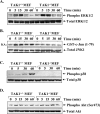TNF-like weak inducer of apoptosis (TWEAK) activates proinflammatory signaling pathways and gene expression through the activation of TGF-beta-activated kinase 1
- PMID: 19201899
- PMCID: PMC2652039
- DOI: 10.4049/jimmunol.0803357
TNF-like weak inducer of apoptosis (TWEAK) activates proinflammatory signaling pathways and gene expression through the activation of TGF-beta-activated kinase 1
Abstract
TWEAK, TNF-like weak inducer of apoptosis, is a relatively recently identified proinflammatory cytokine that functions through binding to Fn14 receptor in target cells. Although TWEAK has been shown to modulate several biological responses, the TWEAK-induced signaling pathways remain poorly understood. In this study, we tested the hypothesis that TAK1 (TGF-beta-activated kinase 1) is involved in TWEAK-induced activation of NF-kappaB and MAPK and expression of proinflammatory protein. TWEAK increased the phosphorylation and kinase activity of TAK1 in cultured myoblast and fibroblast cells. The activation of NF-kappaB was significantly inhibited in TAK1-deficient (TAK1(-/-)) mouse embryonic fibroblasts (MEF) compared with wild-type MEF. Deficiency of TAK1 also inhibited the TWEAK-induced activation of IkappaB kinase and the phosphorylation and degradation of IkappaBalpha protein. However, there was no difference in the levels of p100 protein in TWEAK-treated wild-type and TAK1(-/-) MEF. Furthermore, TWEAK-induced transcriptional activation of NF-kappaB was significantly reduced in TAK1(-/-) MEF and in C2C12 myoblasts transfected with a dominant-negative TAK1 or TAK1 short interfering RNA. TAK1 was also required for the activation of AP-1 in response to TWEAK. Activation of JNK1 and p38 MAPK, but not ERK1/2 or Akt kinase, was significantly inhibited in TAK1(-/-) MEF compared with wild-type MEF upon treatment with TWEAK. TWEAK-induced expression of proinflammatory genes such as MMP-9, CCL-2, and VCAM-1 was also reduced in TAK1(-/-) MEF compared with wild-type MEF. Furthermore, the activation of NF-kappaB and the expression of MMP-9 in response to TWEAK involved the upstream activation of Akt kinase. Collectively, our study demonstrates that TAK1 and Akt are the important components of TWEAK-induced proinflammatory signaling and gene expression.
Figures









Similar articles
-
Tumor necrosis factor-related weak inducer of apoptosis augments matrix metalloproteinase 9 (MMP-9) production in skeletal muscle through the activation of nuclear factor-kappaB-inducing kinase and p38 mitogen-activated protein kinase: a potential role of MMP-9 in myopathy.J Biol Chem. 2009 Feb 13;284(7):4439-50. doi: 10.1074/jbc.M805546200. Epub 2008 Dec 11. J Biol Chem. 2009. PMID: 19074147 Free PMC article.
-
Tumor necrosis factor-like weak inducer of apoptosis inhibits skeletal myogenesis through sustained activation of nuclear factor-kappaB and degradation of MyoD protein.J Biol Chem. 2006 Apr 14;281(15):10327-36. doi: 10.1074/jbc.M511131200. Epub 2006 Feb 6. J Biol Chem. 2006. PMID: 16461349
-
Proinflammatory effects of tumour necrosis factor-like weak inducer of apoptosis (TWEAK) on human gingival fibroblasts.Clin Exp Immunol. 2006 Dec;146(3):540-9. doi: 10.1111/j.1365-2249.2006.03233.x. Clin Exp Immunol. 2006. PMID: 17100776 Free PMC article.
-
Constitutive association of TGF-beta-activated kinase 1 with the IkappaB kinase complex in the nucleus and cytoplasm of human neutrophils and its impact on downstream processes.J Immunol. 2010 Apr 1;184(7):3897-906. doi: 10.4049/jimmunol.0902958. Epub 2010 Mar 3. J Immunol. 2010. PMID: 20200282
-
Cell type-specific function of TAK1 in innate immune signaling.Trends Immunol. 2013 Jul;34(7):307-16. doi: 10.1016/j.it.2013.03.007. Epub 2013 May 7. Trends Immunol. 2013. PMID: 23664135 Review.
Cited by
-
TWEAK/Fn14 Axis: A Promising Target for the Treatment of Cardiovascular Diseases.Front Immunol. 2014 Jan 20;5:3. doi: 10.3389/fimmu.2014.00003. eCollection 2014. Front Immunol. 2014. PMID: 24478772 Free PMC article. Review.
-
Immune and myodegenerative pathomechanisms in inclusion body myositis.Ann Clin Transl Neurol. 2017 May 16;4(6):422-445. doi: 10.1002/acn3.419. eCollection 2017 Jun. Ann Clin Transl Neurol. 2017. PMID: 28589170 Free PMC article. Review.
-
The TWEAK/Fn14/CD163 axis-implications for metabolic disease.Rev Endocr Metab Disord. 2022 Jun;23(3):449-462. doi: 10.1007/s11154-021-09688-4. Epub 2021 Sep 20. Rev Endocr Metab Disord. 2022. PMID: 34542797 Free PMC article. Review.
-
Tumor necrosis factor-like weak inducer of apoptosis stimulation of glioma cell survival is dependent on Akt2 function.Mol Cancer Res. 2009 Nov;7(11):1871-81. doi: 10.1158/1541-7786.MCR-09-0194. Epub 2009 Oct 27. Mol Cancer Res. 2009. PMID: 19861406 Free PMC article.
-
Methotrexate Mechanism of Action in Plaque Psoriasis: Something New in the Old View.J Clin Aesthet Dermatol. 2022 Aug;15(8):42-46. J Clin Aesthet Dermatol. 2022. PMID: 36061481 Free PMC article.
References
-
- Aggarwal BB. Signalling pathways of the TNF superfamily: a double-edged sword. Nat Rev Immunol. 2003;3:745–756. - PubMed
-
- Locksley RM, Killeen N, Lenardo MJ. The TNF and TNF receptor superfamilies: integrating mammalian biology. Cell. 2001;104:487–501. - PubMed
-
- Chicheportiche Y, Bourdon PR, Xu H, Hsu YM, Scott H, Hession C, Garcia I, Browning JL. TWEAK, a new secreted ligand in the tumor necrosis factor family that weakly induces apoptosis. J Biol Chem. 1997;272:32401–32410. - PubMed
Publication types
MeSH terms
Substances
Grants and funding
LinkOut - more resources
Full Text Sources
Molecular Biology Databases
Research Materials
Miscellaneous

